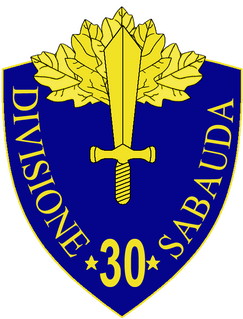Related Research Articles

Operation Husky was a major campaign of World War II in which the Allies invaded the island of Sicily and took it from the Axis powers. It began with a large amphibious and airborne operation, followed by a six-week land campaign, and initiated the Italian Campaign.
The 366th Infantry Regiment was an all African American (segregated) unit of the United States Army that served in both World War I and World War II. In the latter war, the unit was exceptional for having all black officers as well as troops. The U.S. military did not desegregate until after World War II. During the war, for most of the segregated units, all field grade and most of the company grade officers were white.

X Corps was a corps of the British Army that served in the First World War on the Western Front before being disbanded in 1919. The corps was re-formed in 1942 during the Second World War and saw service in the North African Campaign and the Italian Campaign where it came under command of the US Fifth Army and the British Eighth Army.
The 1st Army Corps was first formed before World War I. During World War II it fought in the Campaign for France in 1940, on the Mediterranean islands of Corsica and Elba in 1943 - 1944, and in the campaigns to liberate France in 1944 and invade Germany in 1945.

XIII Corps was a corps-sized formation of the British Army that fought on the Western Front during the First World War and was reformed for service during the Second World War, serving in the Mediterranean and Middle East throughout its service.

The 30th Infantry Division "Sabauda" was an infantry division of the Royal Italian Army during World War II. The Sabauda was based in Cagliari in Sardinia and named for the Latin name of the Royal House of Savoy. After the announcement of the Armistice of Cassibile on 8 September 1943 the division joined the Italian Co-belligerent Army.

The 340th Volksgrenadier Division was a volksgrenadier division of the German Army during the Second World War, active from 1944 to 1945.
The 184th Paratroopers Division "Nembo" was an airborne division of the Royal Italian Army during World War II. After the Armistice of Cassibile the division joined the Italian Co-belligerent Army's Italian Liberation Corps and together with the Polish II Corps liberated Ancona in the Battle of Ancona.

The 36th Infantry Division "Forlì" was a infantry division of the Royal Italian Army during World War II. The Forlì was classified as a mountain infantry division, which meant that the division's artillery was moved by pack mules instead of the horse-drawn carriages of line infantry divisions. Italy's real mountain warfare divisions were the six alpine divisions manned by Alpini mountain troops. The division was formed on 31 March 1939 and named for the city of Forlì. The division was based in Saluzzo and most of its troops were drafted in the surrounding Langhe region in southern Piedmont. The division's two infantry regiments were based in Alba (43rd) and Saluzzo (44th), with the division's artillery regiment also based in Saluzzo.

The 15th Infantry Division "Bergamo" was an infantry division of the Royal Italian Army during World War II. The Bergamo was based in Istria and named for the city of Bergamo.

The 31st Infantry Division "Calabria" was an infantry division of the Royal Italian Army during World War II. The Calabria was formed in Sassari and named for the region of Calabria. The division was part of the garrison of Sardinia, where it remained until the Armistice of Cassibile, after which it served in the Italian Co-belligerent Army.
The 203rd Coastal Division was an infantry division of the Royal Italian Army during World War II. Royal Italian Army coastal divisions were second line divisions formed with reservists and equipped with second rate materiel. Recruited locally, they were often commanded by officers called out of retirement.
The 204th Coastal Division was an infantry division of the Royal Italian Army during World War II. Royal Italian Army coastal divisions were second line divisions formed with reservists and equipped with second rate materiel. Recruited locally, they were often commanded by officers called out of retirement.
The 205th Coastal Division was an infantry division of the Royal Italian Army during World War II. Royal Italian Army coastal divisions were second line divisions formed with reservists and equipped with second rate materiel. Recruited locally, they were often commanded by officers called out of retirement.

The 44th Infantry Division "Cremona" was an infantry division of the Royal Italian Army during World War II. The Cremona was formed on 15 September 1939 by splitting the 20th Infantry Division "Curtatone and Montanara" into the 20th Infantry Division "Friuli" and 44th Infantry Division "Cremona". The division was named for the city of Cremona. The division served as occupation force on Corsica and fought German units after the Armistice of Cassibile was announced on 8 September 1943. The division then served with the Italian Co-belligerent Army and remained active until the 1975 Italian Army reform.
The 212th Coastal Division was an infantry division of the Royal Italian Army during World War II. Royal Italian Army coastal divisions were second line divisions formed with reservists and equipped with second rate materiel. They were often commanded by officers called out of retirement.
The 222nd Coastal Division was an infantry division of the Royal Italian Army during World War II. Royal Italian Army coastal divisions were second line divisions formed with reservists and equipped with second rate materiel. They were often commanded by officers called out of retirement.
The 327th Infantry Division was an infantry division of the German Heer during World War II.
Antonio Basso was an Italian general during World War II.
The VII Army Corps was a corps of the Royal Italian Army between 1877 and 1944.